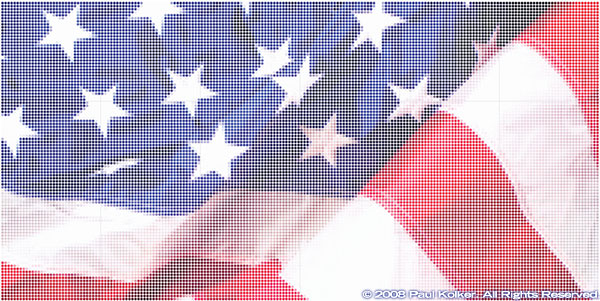
Kolker’s painting style, which he calls fracolor, is based on fractionating a photograph and reconstructing it into colored dots of tints and shades. Kolker’s tint is pure pigment primary color mixed with white; a shade is a tint or primary color mixed with black. The result is distinctive in its color vision and depth perception effects. Because primary colors are not mixed with each other, the colorimetric spectrum spans black to white creating a unique gray scale. And, particularly today, gray is “in”!
Kolker’s photographs have taken on a new depth dimension because of an enhancement process resulting in the high resolution of the printed image. The process relies on the mathematics of the 33×33 dot grid resulting in 1089 dots per inch (dpi). Moreover, the perception of depth is further expanded by backlighting.
Soaring beyond the process, the substance of Kolker’s show is focused on artistic expression and its first amendment free speech protections.
In West Virginia State Board of Education v. Barnette (1943), during World War II and the height of American patriotism, a majority of the court overturned the 1940 Gobitis ruling and voted in favor of two Jehovah’s Witnesses, the Barnette sisters, who refused to salute the flag and recite the pledge of allegiance at the beginning of each school day. The Jehovah’s Witnesses religion permits swearing only to God and prohibits the worship of a graven image including the salute to the American flag.
However, the Barnette case was not argued under the free exercise of religion clause of the first amendment, but under the free speech and expression clause. Silent flag (2008), injet on canvas, 72 × 144 inches, serves as a reminder that individuals may not be coerced by the government to make expressive statements. When protected, freedom of speech includes the right to remain silent, much like the silence of the white canvas surrounding 19,602 dots (1+9+6+0+2=18, 1+8=9) or The Rule of Nine.
Paul Kolker: The Rule of Nine — Opening March 13, 2008.
